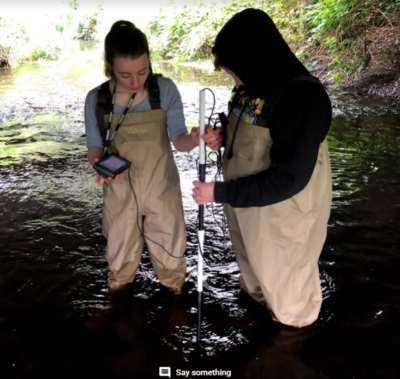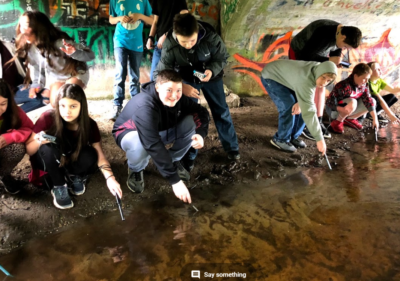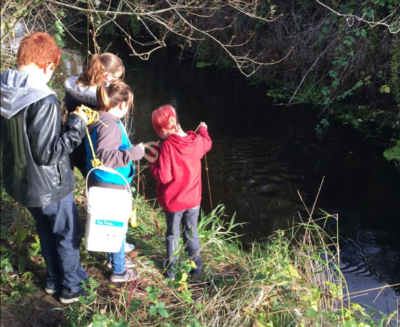Yesterday I wrote a post about partnerships especially as they apply to projects teachers are creating for their students. Having a local partner, such as the North Olympic Salmon Coalition (NOSC), work with my classes has helped make my Environmental Stewardship Project better than I could have made it alone, and has made the project more attractive to grantors.
When looking for grants you want to start with a great project instead of starting with grants. Sure, you could find great grants and then come up with projects to fit the grants but it’s better to have a great project and find grants that could fund it. That way you just have to adapt the same one project to different grants instead of having to design all new projects for different grants. So if your school has resources nearby such as nature or areas where students can make things such as rain gardens, food gardens, greenhouses, or other such activities, design a project taking advantage of those resources. Getting students outdoors or providing a service is especially great. (Click here to see some sample grant proposals that were actually funded.)
 Then look for community partnerships such as master gardeners or other experts working near your school. It’s even better if the organization has an education outreach goal because then you can have a symbiotic relationship that you can count on year after year. Our district has another great resource, the Bluebills. The Bluebills are retired Boeing engineers who work tirelessly to raise money to increase STEM opportunities for kids. They work with schools and raise money to fund learning experiences with the Museum of Flight, among other things, for all our students K-12. I put together proposals to the Bluebills to get two planetariums, bottle rocket experiences, and a robotics program for all our middle school students. The Bluebills also paid for us to take an extra bus full of students to hear an astronaut from the ISS talk live and answer questions. And they have also volunteered in my class and they are helping get Chromebooks and robotics equipment for our primary schools! Having people like that helping our kids is amazing.
Then look for community partnerships such as master gardeners or other experts working near your school. It’s even better if the organization has an education outreach goal because then you can have a symbiotic relationship that you can count on year after year. Our district has another great resource, the Bluebills. The Bluebills are retired Boeing engineers who work tirelessly to raise money to increase STEM opportunities for kids. They work with schools and raise money to fund learning experiences with the Museum of Flight, among other things, for all our students K-12. I put together proposals to the Bluebills to get two planetariums, bottle rocket experiences, and a robotics program for all our middle school students. The Bluebills also paid for us to take an extra bus full of students to hear an astronaut from the ISS talk live and answer questions. And they have also volunteered in my class and they are helping get Chromebooks and robotics equipment for our primary schools! Having people like that helping our kids is amazing.
In the 22 years I’ve worked at Chimacum Middle School I’ve procured over $99,000 from 21 grants just for the Environmental Stewardship Project (21 of my 46 total career grants I’ve gotten have been for that one project) to purchase materials for my students and to take them on field trips beyond that stretch of creek right by our campus. I often say and I’ve also shared at grant writing workshops, having a great project is the way to start getting grants as well as a way to continue getting grants. But you also have to write LOTS of grants. Having a great project won’t get it funded if people don’t know about it.
 I’m pretty darn hopeful that I’m going to secure my 43rd grant and the 19th Environmental Stewardship Project grantmaking 20 straight years of getting at least one grant a year soon! [Note: I did get that one!] The Ocean Guardian Schools project is one of those amazing grant projects that awards grants to schools for multiple years. I submitted a year 2 application and was told that they are waiting to see if funds are available to continue funding schools so it’s not a sure thing but I’m keeping my fingers crossed and thinking good thoughts.
I’m pretty darn hopeful that I’m going to secure my 43rd grant and the 19th Environmental Stewardship Project grantmaking 20 straight years of getting at least one grant a year soon! [Note: I did get that one!] The Ocean Guardian Schools project is one of those amazing grant projects that awards grants to schools for multiple years. I submitted a year 2 application and was told that they are waiting to see if funds are available to continue funding schools so it’s not a sure thing but I’m keeping my fingers crossed and thinking good thoughts.
That’s not the only hope I have to reach my 20th straight year of getting at least one grant per year as I also applied for another grant. Our high school We Act advisor emailed teachers about a grant opportunity back in February, the We Are One Campaign. Looking back through their site and the We Schools site I can’t even find a mention of the grant so that tells me it was a great one to apply for. Grant opps that come your way through emails from your district or other networks are really good to apply for because they don’t tend to be public. If I can find a grant opportunity via a quick search then EVERYBODY can. And those are hard to get because so many people have great project ideas. The application was also very reasonable, easy actually. It’s quite funny how some of the best grants I’ve gotten were actually easy to write while some of the ones I couldn’t get were quite involved and complicated to write! [Note, not only did I not get that one, I never even heard back from them! That was, and is, weird and not common.]
So aside from step one, having a great project, and step two, finding partnerships, and step three writing LOTS of proposals, step four would be to connect with your district office. Find out who gets grants and have them know who you are so they can forward grant opps to you. Better yet, have them email everyone in the district so that grant opps don’t go wasted.
Another person to connect with at your district, besides district admin assistants who get grant info is your district tech people, or person as is often the case. Make friends with your tech person (or if you’re like me, then making friends with your tech people is easy cause we are kindred spirits). If your tech person is not a teacher then help them by being the one to explain how teachers need to use tech with students. Then the tech department will know to ask people like you before making decisions that can affect our students such as firewalls and blocking certain sites decisions. Another reason is so that your tech department, just like your district office, can let you know when money is available. See, writing grants is one way to get money beyond your school building budget but the district also gets money and the squeaky wheel gets the oil. If you are the one doing things and making use of new tech and ideas, then let them know because when money comes their way or they need a new thing tested, they will contact you.
 I would also consider getting on adoption committees. Now, for me, it was an easy process because I alone represented the middle school because we are so small so I was able to propose what I wanted for my 6th program because I’m the only 6th grade Science teacher in the district. But still, if you and the team find something amazing, go for it. I pitched using a science curriculum for grades 7 and 8 that was easily approved while for my own 6th grade I pitched and got approved to use the free STEM Robotics 101 curriculum with Lego Mindstorms EV3 robots. That was a wild, crazy stretch for me so I felt like I won a grant! You see, it would have made sense to get the science curriculum for the entire middle school but I took a risk and proposed something completely different for the 6th grade. A robotics curriculum is not your run of the mill science curriculum and I convinced our school board to let me use with 6th graders! I guess they saw promise in adding robotics and programming to Science.
I would also consider getting on adoption committees. Now, for me, it was an easy process because I alone represented the middle school because we are so small so I was able to propose what I wanted for my 6th program because I’m the only 6th grade Science teacher in the district. But still, if you and the team find something amazing, go for it. I pitched using a science curriculum for grades 7 and 8 that was easily approved while for my own 6th grade I pitched and got approved to use the free STEM Robotics 101 curriculum with Lego Mindstorms EV3 robots. That was a wild, crazy stretch for me so I felt like I won a grant! You see, it would have made sense to get the science curriculum for the entire middle school but I took a risk and proposed something completely different for the 6th grade. A robotics curriculum is not your run of the mill science curriculum and I convinced our school board to let me use with 6th graders! I guess they saw promise in adding robotics and programming to Science.
Here’s another case in point about making connections with your district office and your tech department; our district received a substantial donation to increase student access to computer science courses. I jumped all over that. My principal approached me looking for a middle school programming class. Knowing that there was money, I put together a proposal for just under $6,000 to add really awesome course teaching java programming using the Lego Mindstorms EV3 robots and the free STEM Robotics 102 curriculum.
So next year I will be teaching a 7th and 8th grade Computer Programming elective class with EV3 robots! I’m really looking forward to that and hope the kids love it as much as I’m going to love it! LoL
But I didn’t stop there. I had an idea to upgrade my after school student tech support group. With my after school group, I run that group unpaid and all the monies procured to start that program came from me writing grant proposals. So if you want some district funds you can either use the fact that you already partially funded a program as a way to get more funding or you could say that you are looking for initial funding if you haven’t already procured funds. And, although not ideal, it doesn’t hurt if you aren’t getting paid to do it.
I do have a Donors Choose in the works but I am not good at asking friends, family, parents, and the community for money. It’s one thing to write a proposal to strangers that have money to give but another thing to ask people I know for their money. We’ll see if the Donors Choose project gets funded. I haven’t been able to get one funded yet and I’ve tried a couple. [Note: as of August 22, 2018, my Donors Choose project got funded! Friends, family, and a bunch of amazing community members donated and fulfilled the project! It IS DOABLE!]
Another way I’ve seen teachers get money for their students is by asking. Yeah, the one thing I am really shy about and can’t do I’ve seen other teachers be really successful at. One teacher at my district who taught a multiage program did that masterfully, He would ask for donations from families and community and he got computers for all his students that way. He also had his kids create things such as recipe books and calendars then sell them to parents to fund overnight field trips! It was ingenious. My daughter was in his class for 3rd, 4th, and 5th grade and my wife and I bought all her class’s recipe books and calendars every year with original artwork on them and her own recipes (all kids in the class contributed so every family pretty much bought one to see their child’s contribution).
So let’s break it down. Here are some tips for getting money to do things your school budget cannot afford:
-
Create or adapt or upgrade a really good project. It all starts with the project. Tell what kids will be DOING and not what things you want to buy.
-
Look for partners in your community whether they can provide funds or not. Having experts coming into your classroom is fantastic.
-
If you connect with an organization that provides funding for something you want to do, take advantage of it. Ask them for funding by submitting proposals to them.
-
Connect with your district office and tech department and tell them to let you know of any and all grants that come their way. Those are gold.
-
Next, and this step is important, write and submit proposals to any grant that fits your project! If you get funded you now have a great proposal and for future grants, all you have to do is adapt it to their grant application instead of starting all over!
-
If you have the time and energy, also create new projects for grants that look cool to you and that you have great ideas for that don’t necessarily fit your main project.
-
If there is money available at your district, submit a proposal for using it. Your idea has to fit what the money is for. The worse thing that could happen is that they’ll say no. If they say yes, then you have a project funded!
-
Consider Donors Choose and promote it! Share it far, wide, and continuously.
-
Ask for money of your community by sharing what your kids are doing and asking for funds to have kids do it. It’s much like writing a grant proposal. You have to show what your kids will be doing then sell them on why your program needs money to have the kids do it more or better.
-
Have your students create things and sell those products to parents and family to fund cool things for your students to do.
Once you start getting projects for your students funded it becomes contagious and you want to keep doing it. Well, at least I do. 🙂 It’s doable so my advice is, GO FOR IT!








































































